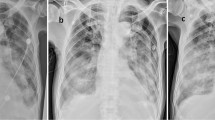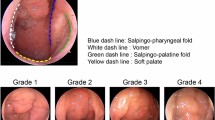Abstract
Objectives
Obstructive sleep apnea syndrome (OSAS) becomes increasingly important. For diagnosis and surgery, computed tomography (CT), and cone beam computed tomography (CB-CT) are used equally, although in most of cases, patient positioning differs between supine positioning (CT) and upright seating positioning (CB-CT). We measured volumetric and anatomical changes in the posterior airway space (PAS) between upright and supine positioning in a three-dimensional set up.
Materials and methods
Coherent CT and CB-CT scans of 55 patients were included in the study. Using Brainlab ENT 3.0, image data was superimposed, and three-dimensional models were segmented. PAS height, cross-sectional area, vertical and horizontal position of the mandible and hyoid, and volumetric analyses of the three-dimensional models were measured.
Results
PAS height and cross-sectional area were significantly higher in CB-CT compared to CT scans (p < 0.001). In the vertical dimension, the mandible and hyoid were localized more caudally in CB-CT in contrast to CT scans (p < 0.04; p < 0.001). Three-dimensional evaluation showed a greater volume of the PAS in CB-CT (p < 0.0001). Pearson correlation coefficient showed a correlation between vertical positioning of the mandible and hyoid compared to the positioning of the patient.
Conclusions
Patient positioning during CT and CB-CT has an effect on the location of anatomical structures like the mandible and hyoid and changes the dimensions and volume of the posterior airway space significantly.
Clinical relevance
The radiological technique used and the positioning of the patient should be taken into account when considering further surgical therapy.









Similar content being viewed by others
References
Kapur VK (2010) Obstructive sleep apnea: diagnosis, epidemiology, and economics. Respir Care 55:1155–1167
Ward KL, Hillman DR, James A, Bremner AP, Simpson L, Cooper MN, Palmer LJ, Fedson AC, Mukherjee S (2013) Excessive daytime sleepiness increases the risk of motor vehicle crash in obstructive sleep apnea. J Clin Sleep Med 9:1013–1021. https://doi.org/10.5664/jcsm.3072
Young T, Palta M, Dempsey J, Skatrud J, Weber S, Badr S (1993) The occurrence of sleep-disordered breathing among middle-aged adults. N Engl J Med 328:1230–1235. https://doi.org/10.1056/NEJM199304293281704
Garvey JF, Pengo MF, Drakatos P, Kent BD (2015) Epidemiological aspects of obstructive sleep apnea. J Thorac Dis 7:920–929. https://doi.org/10.3978/j.issn.2072-1439.2015.04.52
Friedman O, Logan AG (2009) The price of obstructive sleep apnea-hypopnea: hypertension and other ill effects. Am J Hypertens 22:474–483. https://doi.org/10.1038/ajh.2009.43
Sateia MJ (2014) International classification of sleep disorders-third edition. Chest 146:1387–1394. https://doi.org/10.1378/chest.14-0970
Peppard PE, Young T, Palta M, Dempsey J, Skatrud J (2000) Longitudinal study of moderate weight change and sleep-disordered breathing. JAMA 284:3015–3021. https://doi.org/10.1001/jama.284.23.3015
Wetter DW, Young TB, Bidwell TR, Badr MS, Palta M (1994) Smoking as a risk factor for sleep-disordered breathing. Arch Intern Med 154:2219–2224. https://doi.org/10.1001/archinte.1994.00420190121014
Young T, Finn L, Austin D, Peterson A (2003) Menopausal status and sleep-disordered breathing in the Wisconsin Sleep Cohort Study. Am J Respir Crit Care Med 167:1181–1185. https://doi.org/10.1164/rccm.200209-1055OC
Chen H, Aarab G, de Ruiter MHT, de Lange J, Lobbezoo F, van der Stelt PF (2016) Three-dimensional imaging of the upper airway anatomy in obstructive sleep apnea: a systematic review. Sleep Med 21:19–27. https://doi.org/10.1016/j.sleep.2016.01.022
Thapa A, Jayan B, Nehra K, Agarwal SS, Patrikar S, Bhattacharya D (2015) Pharyngeal airway analysis in obese and non-obese patients with obstructive sleep apnea syndrome. Med J Armed Forces India 71:S369–S375. https://doi.org/10.1016/j.mjafi.2014.07.001
Schwab RJ, Gupta KB, Gefter WB, Metzger LJ, Hoffman EA, Pack AI (1995) Upper airway and soft tissue anatomy in normal subjects and patients with sleep-disordered breathing. Significance of the lateral pharyngeal walls. Am J Respir Crit Care Med 152:1673–1689. https://doi.org/10.1164/ajrccm.152.5.7582313
Dempsey JA, Skatrud JB, Jacques AJ, Ewanowski SJ, Woodson BT, Hanson PR, Goodman B (2002) Anatomic determinants of sleep-disordered breathing across the spectrum of clinical and nonclinical male subjects. Chest 122:840–851. https://doi.org/10.1378/chest.122.3.840
Koo SK, Choi JW, Myung NS, Lee HJ, Kim YJ, Kim YJ (2013) Analysis of obstruction site in obstructive sleep apnea syndrome patients by drug induced sleep endoscopy. Am J Otolaryngol 34:626–630. https://doi.org/10.1016/j.amjoto.2013.07.013
Carberry JC, Amatoury J, Eckert DJ (2017) Personalized management approach for obstructive sleep apnea. Chest 153:744–755. https://doi.org/10.1016/j.chest.2017.06.011
Schwartz AR, Schubert N, Rothman W, Godley F, Marsh B, Eisele D, Nadeau J, Permutt L, Gleadhill I, Smith PL (1992) Effect of uvulopalatopharyngoplasty on upper airway collapsibility in obstructive sleep apnea. Am Rev Respir Dis 145:527–532. https://doi.org/10.1164/ajrccm/145.3.527
MacKay SG, Chan L (2016) Surgical approaches to obstructive sleep apnea. Sleep Med Clin 11:331–341. https://doi.org/10.1016/j.jsmc.2016.04.003
Aurora RN, Casey KR, Kristo D, Auerbach S, Bista SR, Chowdhuri S, Karippot A, Lamm C, Ramar K, Zak R, Morgenthaler TI, American Academy of Sleep Medicine (2010) Practice parameters for the surgical modifications of the upper airway for obstructive sleep apnea in adults. Sleep 33:1408–1413
Hatamleh M, Turner C, Bhamrah G, Mack G, Osher J (2016) Improved virtual planning for bimaxillary orthognathic surgery. J Craniofac Surg 27:e568–e573. https://doi.org/10.1097/SCS.0000000000002877
Cevidanes LHC, Tucker S, Styner M, Kim H, Chapuis J, Reyes M, Proffit W, Turvey T, Jaskolka M (2010) Three-dimensional surgical simulation. Am J Orthod Dentofac Orthop 138:361–371. https://doi.org/10.1016/j.ajodo.2009.08.026
Guijarro-Martinez R, Swennen GRJ (2011) Cone-beam computerized tomography imaging and analysis of the upper airway: a systematic review of the literature. Int J Oral Maxillofac Surg 40:1227–1237. https://doi.org/10.1016/j.ijom.2011.06.017
Hofmann E, Schmid M, Lell M, Hirschfelder U (2014) Cone beam computed tomography and low-dose multislice computed tomography in orthodontics and dentistry. J Orofac Orthop/Fortschritte der Kieferorthopädie 75:384–398. https://doi.org/10.1007/s00056-014-0232-x
Van Holsbeke CS, Verhulst SL, Vos WG et al (2014) Change in upper airway geometry between upright and supine position during tidal nasal breathing. J Aerosol Med Pulm Drug Deliv 27:51–57. https://doi.org/10.1089/jamp.2012.1010
Sutthiprapaporn P, Tanimoto K, Ohtsuka M, Nagasaki T, Iida Y, Katsumata A (2008) Positional changes of oropharyngeal structures due to gravity in the upright and supine positions. Dentomaxillofacial Radiol 37:130–135. https://doi.org/10.1259/dmfr/31005700
Barrera JE, Pau CY, Forest V-I, Holbrook AB, Popelka GR (2017) Anatomic measures of upper airway structures in obstructive sleep apnea. World J Otorhinolaryngol - head neck Surg 3:85–91. https://doi.org/10.1016/j.wjorl.2017.05.002
Qu X, Li G, Zhang Z, Ma X (2011) Comparative dosimetry of dental cone-beam computed tomography and multi-slice computed tomography for oral and maxillofacial radiology. Zhonghua Kou Qiang Yi Xue Za Zhi 46:595–599. https://doi.org/10.3760/cma.j.issn.1002-0098.2011.10.006
Camacho M, Capasso R, Schendel S (2014) Airway changes in obstructive sleep apnoea patients associated with a supine versus an upright position examined using cone beam computed tomography. J Laryngol Otol 128:824–830. https://doi.org/10.1017/S0022215114001686
Verin E, Tardif C, Buffet X, Marie JP, Lacoume Y, Andrieu-Guitrancourt J, Pasquis P (2002) Comparison between anatomy and resistance of upper airway in normal subjects, snorers and OSAS patients. Respir Physiol 129:335–343. https://doi.org/10.1016/S0034-5687(01)00324-3
Lye KW (2008) Effect of orthognathic surgery on the posterior airway space (PAS). Ann Acad Med Singap 37:677–682. https://doi.org/10.1007/s12663-014-0687-8
Author information
Authors and Affiliations
Corresponding author
Ethics declarations
Conflict of interest
The authors declare that they have no conflict of interest.
Ethical approval
All procedures performed in studies involving human participants were in accordance with the ethical standards of the institutional and national research committee and with the 1964 Helsinki declaration and its later amendments or comparable ethical standards.
The study was reviewed and approved by the local ethics committee of University Hospital Aachen (EK266/17).
Informed consent
For this type of study, formal consent was not required. All data were collected anonymously.
Rights and permissions
About this article
Cite this article
Ayoub, N., Eble, P., Kniha, K. et al. Three-dimensional evaluation of the posterior airway space: differences in computed tomography and cone beam computed tomography. Clin Oral Invest 23, 603–609 (2019). https://doi.org/10.1007/s00784-018-2478-y
Received:
Accepted:
Published:
Issue Date:
DOI: https://doi.org/10.1007/s00784-018-2478-y




